Click here to learn more about the How to Identify article series.
Name: Spotted lanternfly (Lycorma deliculata)
Range and typical habitat(s): Native range includes China and Japan; is invasive in North America and South Korea
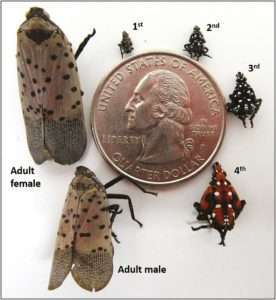
Distinguishing physical characteristics (size, colors, overall shapes, detail shapes) and behaviors: The spotted lanternfly is a distinctive looking insect at any stage of development. The nymphs/instars have round, black bodies that taper to a small head with two large, round, yellowish eyes, one on either side. Younger instars have white spots, while the fourth and final instar additionally features bright red patches on its body. they do not have wings.
The adult spotted lanternfly is about an inch long, and is tan to light grayish-brown with a dark head and legs, and a dark triangle on the shoulders. The forewings also feature dark spots, and a dark web-like pattern at the wingtips, which are rounded in shape. The hindwings are often cover when the insect is at rest, but when spread they display bright red patches with black spots, and the distal ends are black with a white horizontal bar across each. The abdomen is thick and has yellow stripes, and the tip of the abdomen is red. The head is comparatively small, and again has two yellowish round eyes. In spite of having wings, they do not properly fly. Instead, they use these wings to help them leap from one plant to another.
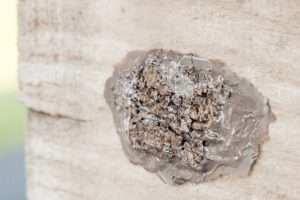
The nymphs usually hatch in April or May. By July, the first adults appear, and prepare to mate and lay eggs. One female can lay up to fifty eggs that are protected in a waxy casing; they look a bit like a clump of clay or dirt stuck to a tree, wall, or other surface. They will overwinter in that spot, and in fact the colder the temperatures the more eggs hatch the following spring. The adults, meanwhile, usually die off by the end of the year; a lanternfly that has reached one year in age is geriatric indeed.
Spotted lanternflies are herbivorous; the nymphs prefer the tree of heaven (Ailanthus altissima), but will also opportunistically feed on other plants, ranging from trees to grapevines to soybeans. The nymphs and adults both suck sap from their host tree using specialized mouthparts, and in sufficient numbers can be deadly to the plant. All told, spotted lanternflies have been observed feeding on the better part of two hundred plant species.
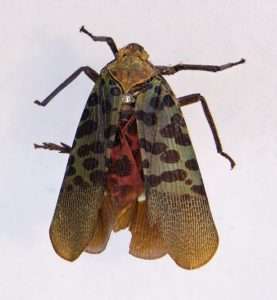
Other organisms it could be confused with and how to tell the difference: There are two other species in the genus Lycorma that look quite similar to L. deliculata; both are found solely in Asia. L. imperialis, found in China, India, and Bangladesh, looks almost identical to L. deliculata, except the base color of the forewings in adults tends to be darker and greener in tone than the grayish-brown seen in L. deliculata. The coloration on L. imperialis’ abdomen may also vary, with orange or red patches being common.
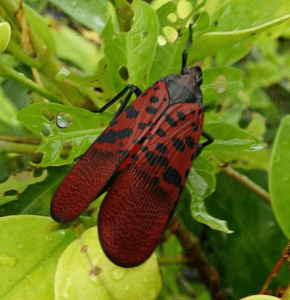
L. meliae is more obviously a different species than L. deliculata. Its forewings are a deep red with the same black spots and webbing pattern. There is also a variant that is solid black except for white spots on the forewings, with a deep red to orange abdomen with black stripes or splotches. L. meliae is only found in Taiwan.
Anything else worth mentioning? Spotted lanternflies are considered to be a highly invasive insect in North America; they arrived by accident in 2014 and have been spreading throughout the northeast since then. They do significant damage to crops such as soybeans (Glycine max) and apples (Malus domestica), and also attack native plants like black walnut (Juglans nigra) and Virginia creeper (Parthenocissus quinquefolia). The nymphs parasitize the tree in such large numbers that they can cause severe damage in a short period of time. Additionally, leaking sap from the tree as well as the nymphs’ waste (honeydew) not only drip onto the plants’ leaves and hinder photosynthesis, but they also promote fungal growth that further injures the plant.
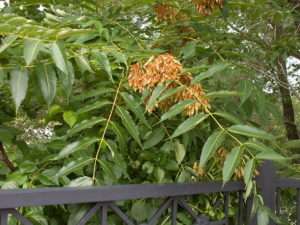
In its native range, the spotted lanternfly’s usual host is the tree of heaven. Like the lanternfly, this tree is also highly invasive in North America, and has been a key factor facilitating the spread of spotted lanternflies. Many efforts to control or prevent the spread of lanterflies involve removing tree of heaven, which can be quite difficult to eliminate completely. However, evidence is growing that lanternfly nymphs that feed on plants other than tree of heaven are not as healthy, and this may be a crucial control in keeping these insects in check.
People in North America who find the nymphs or adults, and especially egg casings, are encouraged to smash them on sight. Other regions around the world that regularly trade agricultural products with China or North American countries are also on the lookout for any sign of spotted lanternflies being introduced.
Further Reading:
USDA APHIS: Spotted Lanternfly
PennState Extension: Spotted Lanternfly
Invasive Bug Prompts Quarantine In Pennsylvania Townships
Spotted Lanternfly in New Jersey: What you need to know
